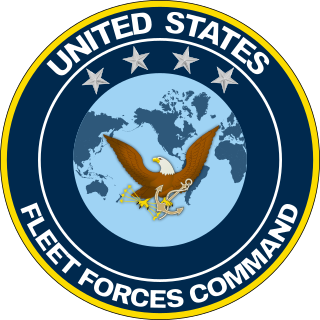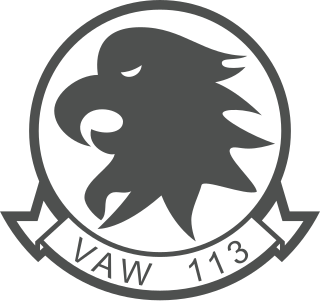
The United States Pacific Fleet (USPACFLT) is a theater-level component command of the United States Navy, located in the Pacific Ocean. It provides naval forces to the Indo-Pacific Command. Fleet headquarters is at Joint Base Pearl Harbor–Hickam, Hawaii, with large secondary facilities at Naval Air Station North Island, California.

The United States Fleet Forces Command (USFFC) is a service component command of the United States Navy that provides naval forces to a wide variety of U.S. forces. The naval resources may be allocated to Combatant Commanders such as United States Northern Command (USNORTHCOM) under the authority of the Secretary of Defense. Originally formed as United States Atlantic Fleet (USLANTFLT) in 1906, it has been an integral part of the defense of the United States of America since the early 20th century. In 2002, the Fleet comprised over 118,000 Navy and Marine Corps personnel serving on 186 ships and in 1,300 aircraft, with an area of responsibility ranging over most of the Atlantic Ocean from the North Pole to the South Pole, the Caribbean Sea, Gulf of Mexico, and the waters of the Pacific Ocean along the coasts of Central and South America.

The Seventh Fleet is a numbered fleet of the United States Navy. It is headquartered at U.S. Fleet Activities Yokosuka, in Yokosuka, Kanagawa Prefecture, Japan. It is part of the United States Pacific Fleet. At present, it is the largest of the forward-deployed U.S. fleets, with 50 to 70 ships, 150 aircraft and 27,000 Sailors and Marines. Its principal responsibilities are to provide joint command in natural disaster or military operations and operational command of all U.S. naval forces in the region.

The Fifth Fleet is a numbered fleet of the United States Navy. Its area of responsibility encompasses approximately 2.5 million square miles, and includes the Persian Gulf, Red Sea, Arabian Sea, and parts of the Indian Ocean. It shares a commander and headquarters with U.S. Naval Forces Central Command (NAVCENT) in Bahrain. Fifth Fleet/NAVCENT is a component command of, and reports to, U.S. Central Command (CENTCOM).

The United States Second Fleet is a numbered fleet in the United States Navy responsible for operations in the East Coast and North Atlantic Ocean. Established after World War II, Second Fleet was deactivated in 2011, when the United States government believed that Russia's military threat had diminished, and reestablished in 2018 amid renewed tensions between NATO and Russia.

Airborne Command & Control Squadron 113 (VAW-113), known as "Black Eagles", was established on 20 April 1967 flying the E-2A Hawkeye.

Carrier Strike Group 3 is a U.S. Navy carrier strike group. Carrier strike groups gain and maintain sea control as well as project naval airpower ashore. The aircraft carrier USS Abraham Lincoln (CVN-72) is the group's current flagship. Other units assigned as of 2024 include Carrier Air Wing Nine, the Arleigh Burke-class destroyersUSS O'Kane (DDG-77), USS Frank E. Petersen Jr. (DDG-121), and USS Spruance (DDG-111), which are part of Destroyer Squadron 21.

Nora Wingfield Tyson is a retired United States Navy vice admiral. In 2015, she was installed as commander of the Third Fleet, making her the first woman to lead a United States Navy ship fleet. She retired from service in 2017. Tyson previously served as the commander of Carrier Strike Group Two, from July 29, 2010 to January 12, 2012; she was the first female commander of a United States Navy Carrier Strike Group. She then served as Vice Director of the Joint Staff beginning in February 2012. In July 2013 she was promoted to vice admiral and named as Deputy Commander, United States Fleet Forces Command.

Commander, Carrier Strike Group FOUR is the U.S. Fleet Forces Command formation charged with training and certifying Atlantic Fleet Carrier Strike Groups, Amphibious Ready Groups, and independently deploying surface ships. Its mission is to "Conduct safe and effective Strike Force Training of the Atlantic Fleet."

Carrier Strike Group Seven was a U.S. Navy carrier strike group active from October 2004 until 30 December 2011. The strike group's antecendants included two previous aircraft carrier formations, Carrier Division Seven and Carrier Group Seven. Its heritage thus includes the Second World War, the Vietnam War, and the Cold War, as well as the first and the second Persian Gulf wars, encompassing a total of 34 deployments to the Western Pacific Ocean and Persian Gulf.

Carrier Strike Group Three 2004–2009 operations included a world cruise, three western Pacific (WESTPAC) deployments and a change-over of its flagship. During this period, CARSTRGRU-3 provided combat operational support for Operation Iraqi Freedom and Operation Enduring Freedom – Afghanistan (OEF-A) as well as participated such major exercises as Valiant Shield 2007, Key Resolve/Foal Eagle 2009, and Northern Edge 2009. The strike group's 2005 WESTPAC deployment marked the final overseas mission for Sea Control Squadron 33 (VS-33), the Screwbirds. Helicopter Maritime Strike Squadron 71 (HSM-71), a new component to Carrier Air Wing Nine (CVW-9), became the first squadron of its kind to embark on board a carrier as part of a carrier air wing when it operated with Carrier Strike Group Three during its 2009 WESTPAC deployment
Carrier Strike Group 6 was a United States Navy carrier strike group. Its last homeport was Naval Station Mayport at the mouth of the St. Johns River near Jacksonville, Florida. Fifty-one Rear Admirals served as Commander, Carrier Division/Group/Strike Group 6 from August 1944 until the command was deactivated in April 2007.

Carrier Strike Group 5, also known as CSG 5 or CARSTRKGRU 5, is the U.S. Navy carrier strike group assigned to the United States Pacific Fleet and permanently forward deployed to the U.S. 7th Fleet. The Strike Group Flagship is the Nimitz-class aircraft carrier USS George Washington (CVN-73) which also embarks Strike Warfare Commander, Carrier Air Wing Five and its nine squadrons. As of June 2015, CSG 5 includes two Ticonderoga-class cruisers and Destroyer Squadron Fifteen, which serves as the Sea Combat Commander and is responsible for nine assigned Arleigh Burke-class destroyers.

Michael A. Brookes is a United States Navy rear admiral who serves as the director of the National Maritime Intelligence-Integration Office and commander of the Office of Naval Intelligence. He previously served as the director of intelligence of the U.S. Southern Command and U.S. Strategic Command.

John Vincent Fuller is a United States Navy vice admiral who serves as the 42nd Naval Inspector General since June 11, 2021. Prior to that, Fuller served as deputy director for force protection of the Joint Staff and before that as the director of strategy, plans, and policy of the United States Northern Command.

Samuel John Paparo Jr. is a United States Navy admiral who has served as the commander of United States Indo-Pacific Command since May 3, 2024. He most recently served as commander of the United States Pacific Fleet from 2021 to 2024.

Robert Berry Chadwick II is a United States Navy rear admiral and surface warfare officer who served as the commander of Carrier Strike Group 9 from July 9, 2021 to June 2, 2023. He most recently served as the commander of Navy Region Hawaii and Naval Surface Group Middle Pacific from June 14, 2019 to June 18, 2021. Prior to that, Chadwick served as the 87th Commandant of Midshipmen at the United States Naval Academy from June 2017 to June 2019, with tours as commander of Destroyer Squadron 21 from March 2015 to August 2016 and commanding officer of USS Roosevelt (DDG-80) from November 2010 to July 2011.

Craig A. "Clap" Clapperton is a United States Navy vice admiral and naval flight officer who serves as the commander of U.S. Fleet Cyber Command and the United States Tenth Fleet since August 4, 2022. He most recently served as the commander of Combined Joint Task Force, Cyber from June 30, 2021, to June 7, 2022. He previously served as commander of Carrier Strike Group 12 from May 7, 2020, to June 17, 2021.

Paul C. Spedero Jr. is a United States Navy rear admiral and naval aviator who has served as the vice director for operations of the Joint Staff since June 2023. He most recently served as the commander of Carrier Strike Group 8 from May 31, 2022 to June 1, 2023. He most recently served as commander of the Joint Enabling Capabilities Command from July 9, 2021 to May 23, 2022, and prior to that as director for fleet integrated readiness and analysis on the staff of the United States Fleet Forces Command.

Michael P. "Buzz" Donnelly is a United States Navy rear admiral and naval flight officer who has served as Director of Air Warfare of the United States Navy since August 3, 2023. He most recently served as the commander of Carrier Strike Group 5 and Task Force 70 from October 2021 to June 2023. He previously served as the 37th commander of United States Naval Forces Korea, concurrently serving as commander of Navy Region Korea and Task Force 78 from April 2019 to September 2021.


















